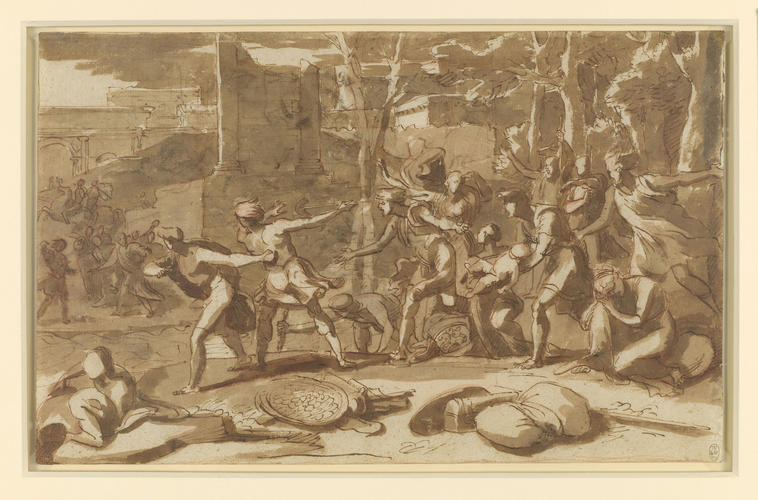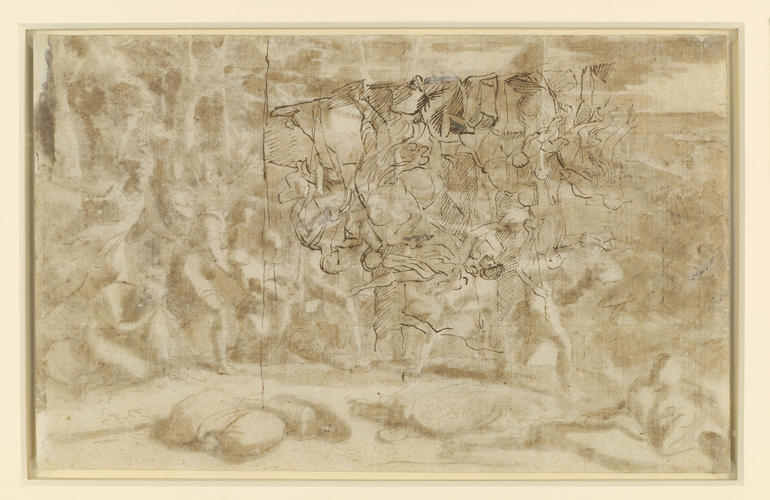-
1 of 253523 objects
The Saving of the Infant Pyrrhus c.1633-4
Pen and brown ink, with brown wash, over red chalk | 20.6 x 34.5 cm (sheet of paper) | RCIN 911909

Nicolas Poussin (1594-1665)
The Saving of the Infant Pyrrhus c.1633-4

Nicolas Poussin (1594-1665)
The Saving of the Infant Pyrrhus c.1633-4


-
A drawing of a group of agitated figures, holding a baby at the centre, two of them throwing a rock and a spear across a river to other figures on the other bank.
This magnificent sheet is the only surviving preparatory study for a painting (now in the Louvre) for the Abate Gian Maria Roscioli of Foligno, who noted the payment of seventy scudi in his account book on 2 September 1634. It depicts an episode from the life of Pyrrhus, who as an infant was carried to safety at Megara when his father King Aeacides was driven from Epirus. His protectors found the river outside the city impassable, but with the enemy in close pursuit, they threw across messages attached to a stone and a spear, and the Megarans sent a boat to rescue the child (Plutarch, Life of Pyrrhus, 2).
The sheet comes close to the peak of Poussin's mature graphic style. The long-limbed figures are constructed with fast, flowing strokes of the pen, and the rich wash, which covers most of the drawing's surface, articulates the composition with strong rhythmic contrasts across the agitated figure group. The stormy background is an almost uniform layer of wash, the ragged fringes of white paper around trees and buildings giving a powerful contre-jour effect. The drawing also represents one of the high points of Poussin's lifelong pursuit of the depiction of human emotion, which flows through the figures with frantic intensity. The lunging figure at the right, pointing behind to the pursuing forces, pushes forward the youth who holds Pyrrhus. At the centre, another strides forwards, at once pointing at the infant and exhorting the two at the front of the group, who strain their muscles in opposing actions to fling the messages across the river to the agitated crowd beyond. The composition falls downwards and outwards at its edges, and there is a sense that Poussin is barely in control of the pictorial forces at his disposal.
On the verso is an earlier sketch for the same composition, in pen alone, upside-down with respect to the recto. Poussin builds up the group figure by figure in semi-abstract outlines and blocks of parallel hatching, giving some odd disparities of scale. Interestingly this suggests that he was not at this point thinking in terms of the overall composition, but was primarily concerned with the human responses of the figures as a chain of actions and reactions. In the painting much of this energy has been arrested. The surging flow of the drawing is broken as two maidens look backwards and upwards in anguish at the fighting, now visible at the far right, and the message-hurlers have raised their aim, giving an overall upwards curve to the composition which now comes to rest at the edges of the picture.
The figures of the two message-throwers are related to drawings added by Poussin to a manuscript of Leonardo da Vinci's Treatise on Painting, copied for Cassiano dal Pozzo from an earlier (and incomplete) version in the Barberini library. Cassiano intended that Poussin's designs should be engraved and the treatise published, but this did not appear until 1651. The original Cassiano/Poussin manuscript of the Treatise is in the Ambrosiana Library in Milan, though four sets of copies of the drawings are known, including a series of sixteen at Windsor (RCIN 911951-66). The two figures in the Pyrrhus drawing correspond to those illustrating a paragraph on the stance of bodies in action beginning "A man who wishes to throw a spear or a rock ...".Provenance
Cardinal Camillo Massimi (1620-1677); from whose heirs bought in 1739, for 300 scudi, by Richard Mead (1673-1754); probably presented to Frederick, Prince of Wales, by 1750.
-
Creator(s)
Acquirer(s)
-
Medium and techniques
Pen and brown ink, with brown wash, over red chalk
Measurements
20.6 x 34.5 cm (sheet of paper)
Category
Object type(s)
Other number(s)
RL 11909Alternative title(s)
Pirro inseguito da Molossi